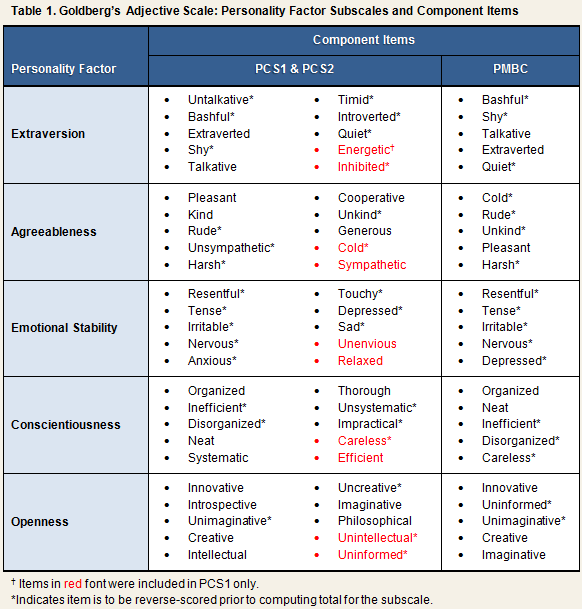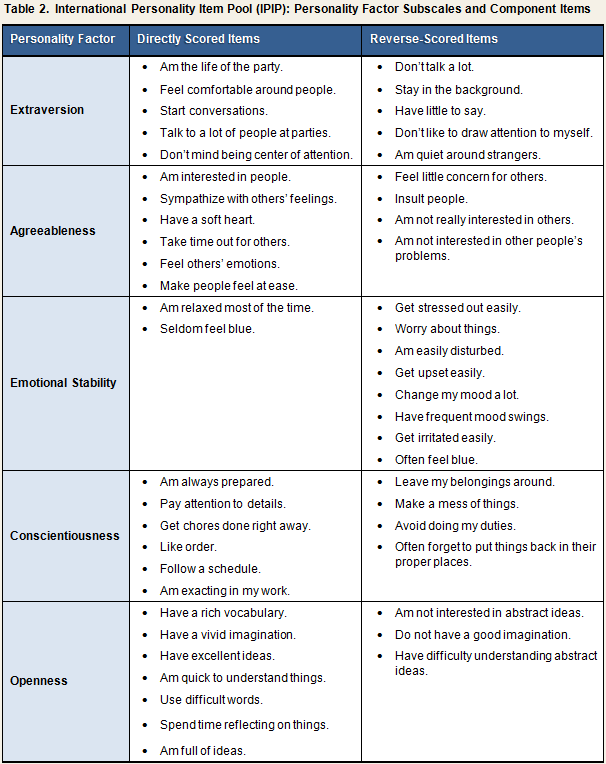Big Five Personality Factors (PCS1, PCS2, PMBC, PCS3)
TitleGoldberg's Adjective Scale - 50-item version; 25-item version StudiesPCS1, PCS2, PMBC Copyright InformationAvailable in the public domain Primary ReferenceGoldberg, L. R. (1992). The development of markers for the big-five factor structure. Psychological Assessment, 4, 26-42. PurposeTo assess standing along five major dimensions of personality: (1) extraversion, (2) agreeableness, (3) conscientiousness, (4) neuroticism, and (5) openness. Type of MeasureModified. To reduce participant burden, the Cold Studies employed abbreviated versions of this scale, rather than the original 100-item instrument created by Goldberg. Further modifications to the scale include replacing some of the adjectives that were included in the original scale with terms that may be more understandable among a broader population (e.g., uninformed substituted for unsophisticated), and condensing the response options from a range of 1 to 9 to a range of 1 to 5 (see Scaling, below). DescriptionParticipants are instructed to rate the extent to which each of several trait-related adjectives accurately reflects how they are generally or typically, as compared with other persons they know of the same sex and approximately the same age. In PCS1 and PCS2, Goldberg’s Adjective Scale was administered on 2 occasions during the pre-quarantine baseline period, separated either by one week or approximately 8 weeks for the former and latter study, respectively (see PCS1 and PCS2 Trial Outlines). In PMBC, the extraversion and agreeableness subscales were administered as a unique questionnaire during the pre-quarantine baseline and then again when the entire scale (i.e., all 5 subscales) was administered on Quarantine Day 0 (see PMBC Trial Outline). ScalingOriginal1 = extremely inaccurate, 2 = very inaccurate, 3 = quite inaccurate, 4 = slightly inaccurate, 5 = neither inaccurate nor accurate, 6 = slightly accurate, 7 = quite accurate, 8 = very accurate, 9 = extremely accurate Modified0 = Not at all accurate, 1 = A little accurate, 2= Moderately accurate, 3 = Quite a bit accurate, 4 = Extremely accurate Number of ItemsPCS1: 50 (10 for each dimension) Items/ScoringTotal scores indicating relative levels of each of the five personality dimensions are computed by summing the values of their component items. Table 1 displays each of the five factors and the items used to assess them in PCS1, PCS2, and PMBC, respectively.
PsychometricsIn PCS1Internal Consistency Reliability: 0.79-0.86 for each dimension In PCS2Internal Consistency Reliability: 0.76-0.85 for each dimension In PMBCInternal Consistency Reliability: alpha=0.66-0.80 for each dimension Variables
|
TitleInternational Personality Item Pool (IPIP) Big-Five Factor Markers StudyPCS3 Copyright InformationAvailable in the public domain Primary ReferencesGoldberg, L. R., Johnson, J. A., Eber, H. W., Hogan, R., Ashton, M. C., Cloninger, C. R., & Gough, H. C. (2006). The International Personality Item Pool and the future of public-domain personality measures. Journal of Research in Personality, 40, 84-96. PurposeTo assess standing along five major dimensions of personality: (1) extraversion, (2) agreeableness, (3) conscientiousness, (4) emotional stability, and (5) openness. Type of MeasureEstablished. The IPIP is comprised of several scales that measure multiple psychological constructs. Participants in PCS3 were administered the five 10-item scales that measure the Big-Five broad domains or Big-Five Factor Markers (see http://ipip.ori.org/newMultipleconstructs.htm). DescriptionParticipants are instructed to rate the extent to which each in a set of 50 self-referent descriptive phrases accurately reflects how they are generally or typically, as compared with other persons they know of the same sex and approximately the same age. The extraversion and agreeableness subscales of the IPIP were administered during the pre-quarantine baseline period; whereas the entire IPIP (i.e., all 5 subscales) was administered on Quarantine Day 0 (see PCS3 Trial Outline). Scaling1 = Very Accurate, 2 = Moderately Inaccurate, 3 = Neutral, 4 = Moderately Accurate, 5 = Very Accurate Number of Items50 (10 per dimension) Items/ScoringTotal scores indicating relative levels of each of the five personality dimensions are computed by summing the values of their component items. Table 2 displays each of the five factors and the items used to assess them.
PsychometricsInternal consistencies (Cronbach’s α) for each of the five scales using data from the PCS3 sample (n=213) are provided below:
Test-retest correlations (Pearson’s r) for extraversion and agreeableness are .85 and .82, respectively. |

